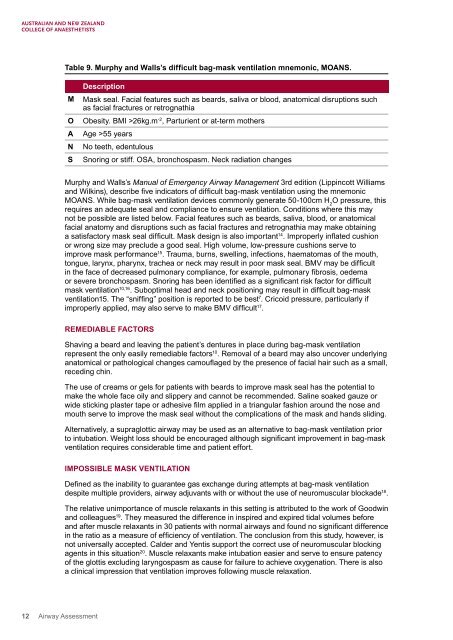Airway Assessment
2cKbSEQ
2cKbSEQ
You also want an ePaper? Increase the reach of your titles
YUMPU automatically turns print PDFs into web optimized ePapers that Google loves.
Table 9. Murphy and Walls’s difficult bag-mask ventilation mnemonic, MOANS.<br />
M<br />
O<br />
A<br />
N<br />
S<br />
Description<br />
Mask seal. Facial features such as beards, saliva or blood, anatomical disruptions such<br />
as facial fractures or retrognathia<br />
Obesity. BMI >26kg.m -2 , Parturient or at-term mothers<br />
Age >55 years<br />
No teeth, edentulous<br />
Snoring or stiff. OSA, bronchospasm. Neck radiation changes<br />
Murphy and Walls’s Manual of Emergency <strong>Airway</strong> Management 3rd edition (Lippincott Williams<br />
and Wilkins), describe five indicators of difficult bag-mask ventilation using the mnemonic<br />
MOANS. While bag-mask ventilation devices commonly generate 50-100cm H 2<br />
O pressure, this<br />
requires an adequate seal and compliance to ensure ventilation. Conditions where this may<br />
not be possible are listed below. Facial features such as beards, saliva, blood, or anatomical<br />
facial anatomy and disruptions such as facial fractures and retrognathia may make obtaining<br />
a satisfactory mask seal difficult. Mask design is also important 14 . Improperly inflated cushion<br />
or wrong size may preclude a good seal. High volume, low-pressure cushions serve to<br />
improve mask performance 15 . Trauma, burns, swelling, infections, haematomas of the mouth,<br />
tongue, larynx, pharynx, trachea or neck may result in poor mask seal. BMV may be difficult<br />
in the face of decreased pulmonary compliance, for example, pulmonary fibrosis, oedema<br />
or severe bronchospasm. Snoring has been identified as a significant risk factor for difficult<br />
mask ventilation 10,16 . Suboptimal head and neck positioning may result in difficult bag-mask<br />
ventilation15. The “sniffing” position is reported to be best 7 . Cricoid pressure, particularly if<br />
improperly applied, may also serve to make BMV difficult 17 .<br />
REMEDIABLE FACTORS<br />
Shaving a beard and leaving the patient’s dentures in place during bag-mask ventilation<br />
represent the only easily remediable factors 10 . Removal of a beard may also uncover underlying<br />
anatomical or pathological changes camouflaged by the presence of facial hair such as a small,<br />
receding chin.<br />
The use of creams or gels for patients with beards to improve mask seal has the potential to<br />
make the whole face oily and slippery and cannot be recommended. Saline soaked gauze or<br />
wide sticking plaster tape or adhesive film applied in a triangular fashion around the nose and<br />
mouth serve to improve the mask seal without the complications of the mask and hands sliding.<br />
Alternatively, a supraglottic airway may be used as an alternative to bag-mask ventilation prior<br />
to intubation. Weight loss should be encouraged although significant improvement in bag-mask<br />
ventilation requires considerable time and patient effort.<br />
IMPOSSIBLE MASK VENTILATION<br />
Defined as the inability to guarantee gas exchange during attempts at bag-mask ventilation<br />
despite multiple providers, airway adjuvants with or without the use of neuromuscular blockade 18 .<br />
The relative unimportance of muscle relaxants in this setting is attributed to the work of Goodwin<br />
and colleagues 19 . They measured the difference in inspired and expired tidal volumes before<br />
and after muscle relaxants in 30 patients with normal airways and found no significant difference<br />
in the ratio as a measure of efficiency of ventilation. The conclusion from this study, however, is<br />
not universally accepted. Calder and Yentis support the correct use of neuromuscular blocking<br />
agents in this situation 20 . Muscle relaxants make intubation easier and serve to ensure patency<br />
of the glottis excluding laryngospasm as cause for failure to achieve oxygenation. There is also<br />
a clinical impression that ventilation improves following muscle relaxation.<br />
12 <strong>Airway</strong> <strong>Assessment</strong>


